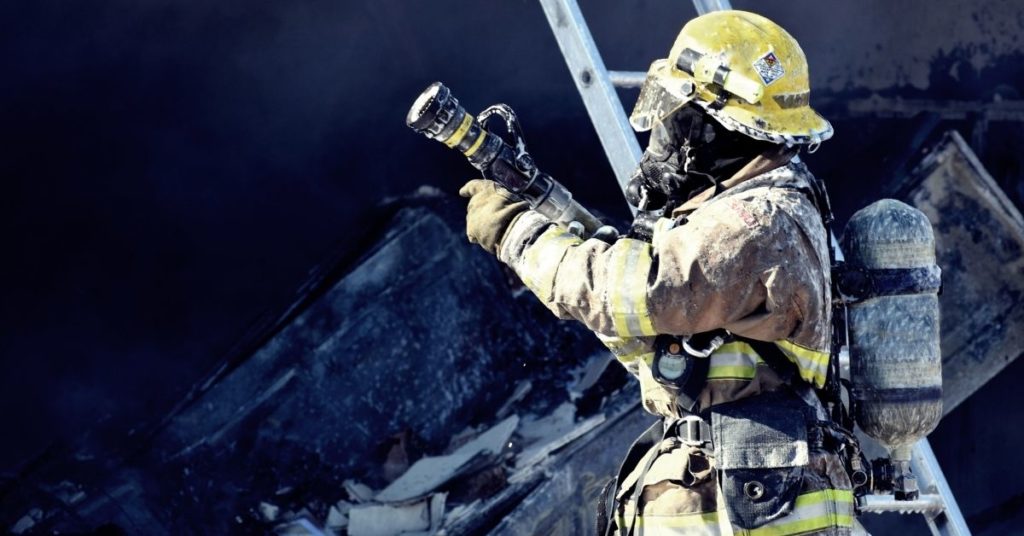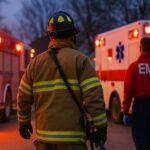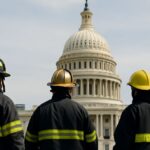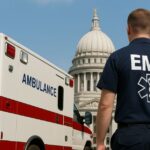Updated: January 27, 2022
Cancer is the leading cause of line-of-duty deaths suffered by America’s firefighters, but the government, whether state or federal, has historically been slow to act on legislation which would cover firefighters from the wide range of cancers being increasingly linked to the firefighting profession. At the root of this cancer pandemic suffered in the firefighting community is the frequent exposure to dangerous chemicals both because of the fire, but also, because they are found in flame retardants used to fight the fires themselves.
Presumptive Cancer Coverage for Firefighters
Below are two important legislative wins at the state level, and the current state of the conversation federally:
A major victory for firefighters was won in North Carolina at the end of last year. The lack of presumptive cancer coverage in that state was of particular concern to this organization. Legislators in North Carolina had tried for years to pass presumptive cancer coverage for their firefighters without success. Now, firefighters in North Carolina have finally received the protection afforded to their peers around the country. The Citizen Times reported that “included in the two-year budget signed by (Governor) Cooper is legislation that appropriates $15 million in funding over two fiscal years to establish and administer a pilot program to provide health benefits for eligible firefighters with a new diagnosis of cancer after Jan. 1.” This is a landmark program in North Carolina, finally bringing the state up to par with the rest of the country.
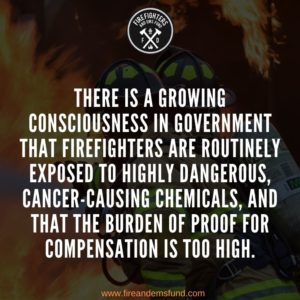
And while North Carolina finally enshrined this protection to firefighters, others expanded their coverage. One such state was Virginia. Christopher Griffin was a Norfolk Virginia firefighter suffering from terminal brain cancer- a condition which was not covered by the state’s presumptive cancer protections. He successfully sued the state and became the first firefighter to win compensation under expanded coverage. Sadly, he passed away a week later, in October of last year. The new legislation in Virginia “adds multiple types of cancer, including brain, colon and testicular cancer, to the list of conditions that are assumed work-related when firefighters seek worker’s compensation in the state,” FireRescue1 reported.
In the time since this blog was published in 2020, the federal government has also begun to take more proactive steps in protecting federal firefighters. H.R. 2499 was introduced in the House of Representatives on April 14, 2021. The bill as written would decide:
“…that (1) heart disease, lung disease, and specified cancers of federal employees employed in fire protection activities for at least 5 years are presumed to be proximately caused by such employment if the employee is diagnosed with the disease within 10 years of employment; and (2) the disability or death of the employee due to such disease is presumed to result from personal injury sustained in the performance of duty.“
There is a growing consciousness in government that firefighters are routinely exposed to highly dangerous, cancer-causing chemicals, and that the burden of proof for compensation is too high, noted the International Association of Firefighters:
“Having repeatedly weighed in with members of Congress on this legislation, General President Edward Kelly notes that the burdens placed on federal fire fighters to identify a specific toxin or incident of exposure are too high and the rigidity of this requirement unnecessarily impedes federal fire fighters from the benefits they deserve.“
Action at the federal level to protect the federally employed firefighters in America with proper presumptive cancer coverage would set a precedent that could not be ignored at the state level. Advancing this bill and securing this protection will be a top priority for Fire & EMS advocates and would be a major milestone for the country’s firefighters if passed.
Presumptive cancer coverage in America is not perfect. But these new developments are testaments to the growing momentum that legislation advocating for firefighters has gained over the last 18 months. Grassroots efforts and tireless advocacy have successfully elevated the needs of our nation’s firefighters, and with continued persistence, we are confident that more victories are on the horizon.
Published: August 6, 2020
Cancer in the Fire Industry
It’s no secret that a firefighter’s job is riskier than the average career. From a physical perspective, firefighters risk burns, collapsing structures, and smoke inhalation from burning buildings. Mentally, they risk PTSD after seeing sometimes fatal emergencies transpire. When considering all the factors that can take a toll on the lives of firefighters, these are the first that come to mind. But the deadliest risk to those in the fire industry isn’t burns or mental anguish; it’s cancer. In fact, since 2002, almost two out of every three firefighters who died in the line of duty died of cancer, according to the International Association of Fire Fighters.
According to a multi-year study done by the National Institute for Occupational Safety and Health (NIOSH), firefighters have a greater number of cancer diagnoses and cancer-related deaths than the general public. These were mostly digestive, oral, respiratory, and urinary cancers. The most alarming, however, was that there were twice as many firefighters with malignant mesothelioma, a rare and aggressive cancer caused by exposure to asbestos. The study compared firefighter illness to the general public, but also between the firefighters themselves. They found that the number of runs that firefighters responded to statistically increased the likelihood of contracting some form of cancer, specifically lung and leukemia.
While it’s almost impossible to pinpoint the exact cause of cancer, the study provided significant evidence that firefighters are at increased risk of cancer as a result of occupational exposure.
Firefighter Cancer: Result of Occupational Exposure
What exactly are they being exposed to that is so deadly? It’s not fire itself, but the fumes that come off of burning buildings. According to the Leukemia and Lymphoma society, modern homes and buildings contain many synthetic and plastic materials that create more smoke when burning than natural materials. When materials burn, they release a number of carcinogens including polycyclic aromatic hydrocarbons (PAHs), a group of more than 100 chemicals. Exposure to PAHs is proven to cause cancer. Firefighters may also encounter other known carcinogens such as asbestos and diesel exhaust, which can be inhaled or absorbed through the skin.
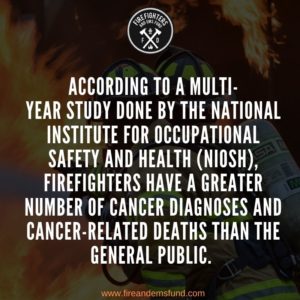
Firefighters aren’t completely unarmed in this battle, though. Wearing proper personal protective equipment (PPE), including self-contained breathing apparatuses (SCBA), offers protection against these toxic chemicals. However, what hinders the effectiveness of PPE is how quickly firefighters can get it off. In an interview with CBS News, Dr. Jeffrey Burgess, a cancer researcher at the University of Arizona, says one of the easiest things that firefighters can do to help reduce cancer risk is wash their gear and themselves immediately after a call. “When they go to a fire, they get the cancer-causing chemicals over all their gear,” he said. “In the past they wouldn’t segregate their gear. They may go sit down in their living quarters maybe with their gear on and get it on the couches, et cetera.” Soiled PPE cross-contaminates everything it touches, creating a risk for not only firefighters, but anyone that comes in contact with their gear before it has been decontaminated.
Since the link between chemical exposure and cancer has been established, more intense measures have been taken to protect fire departments from heightened risk. Exposure prevention efforts like proper training on PPE and increased cleaning of equipment are a cost-effective way to reduce occupational cancer risk. However, most fire departments cannot afford station updates that would make the biggest impact on chemical exposure: a second set of gear. When clean, carcinogenic-free safety equipment is not readily available, firefighters are left scrambling for whatever they can find. Time-sensitive emergencies take precedent over ensuring all equipment is clean and ready-to-use, forcing firefighters to choose between potentially saving a life, or risking chemical exposure. While an abundance of gear and PPE should be in every department, most cannot afford it. Widespread lack of funding across the nation is leaving departments with mass lay-offs, broken and outdated technology, and at best, single sets of gear for employees. Lack of awareness and support from the public has led to poor funding, which affects not only the safety and health of firefighters, but also how quickly and efficiently they can respond to emergencies.
Firefighter Cancer Laws
While fire departments have been forced to find low-cost ways to increase safety measures to protect their firefighters, many are still diagnosed and pass away from cancer every year, and more work needs to be done on the state level to offer protection. A growing number of states have passed laws designed to help firefighters who develop cancer, according to the non-profit Firefighter Cancer Support Network. These laws ensure that a firefighter cancer diagnosis is presumed to be caused by their job, even if the firefighter is in retirement. In theory, these laws promise workers’ compensation, disability benefits, or even death benefits for firefighters and their families. But even these laws still leave many coming up short. Leaders of organizations that work with firefighters say, despite these laws, firefighters are often denied workers’ compensation claims after a cancer diagnosis. While there is an abundance of medical evidence proving the link between occupational exposure and cancer, it is nearly impossible to pinpoint the exact chemical, dates of exposure, and causes of exposure that lead to the diagnosis. Insurance companies find loopholes in the laws, and even when they can’t, they drag sick firefighters and their families through emotionally and financially taxing legal battles, all while they’re suffering through cancer treatment. The burden of proof they’re faced with providing leave many unwilling and unable to continue their battle for fair compensation. As a result, many firefighters are left with absolutely nothing after years of sacrifice to provide a public duty in order to keep their communities safe.
Thankfully, in July 2018, President Trump signed the Firefighter Cancer Registry Act, directing the Centers for Disease Control and Prevention to collect national data on the presence of cancer in the fire industry. NIOSH will look into various trends related to the issue, including the effects on firefighters of different genders, races, ages, and locations. Hopefully, this data will leave legislators without a shadow of a doubt that firefighters need better protection. In the meantime, call on policy makers to enforce stricter laws around firefighter protection. You can also help raise awareness around funding to ensure that your local fire department is equipped with everything they need to keep themselves, and in turn, you, safe.
Are you a firefighter who has been diagnosed with cancer? Do you know of a hero in need? We want to hear from you, and we want to help. Contact us here.

